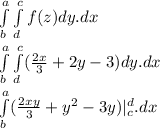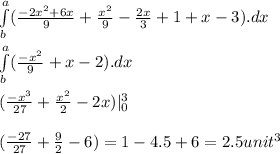Answer:
2.5 units^3
Explanation:
Given:-
- The solid is bounded by a plane defined by the following points:
P(3, 0, 0), Q(0, 1, 0),R(0, 0, 2)
Find:-
Use a double integral to find the volume of the solid in the first octant bounded by the plane
Solution:-
- Determine the equation of the plane. Compute two direction vectors d1 and d2 that lie on the plane:
d1 = P - Q
d1 = (3, 0, 0) - (0, 1, 0) = (3,-1,0)
d2 = P - R
d2 = (3, 0, 0) - (0, 0, 2) = (3,0,-2)
- Find the a vector "normal" - n to the plane by cross product formulation of direction vectors (d1 and d2) that lie on the plane:
![n = d1xd2 = \left[\begin{array}{c}3&-1&0\end{array}\right] x \left[\begin{array}{c}3&0&-2\end{array}\right] = \left[\begin{array}{ccc}3&-1&0\\3&0&2\end{array}\right] = \left[\begin{array}{c}-2&-6&3\end{array}\right]](https://img.qammunity.org/2021/formulas/mathematics/high-school/t8cf1dez8qujbw8zerrbiww4q2n65d24h0.png)
- The equation of plane is:
n.(x,y,z) = n.P
-2x -6y + 3z = -6
- The function of one variable would be:
z = (2/3)x + 2y - 2
- The double integration formulation would be:

- Where the limits (c and d) are defined by planar (x-y) projection of plane (n) :
y = d = -(1/3)x + 1
c = 0
- Evaluate the limits:
